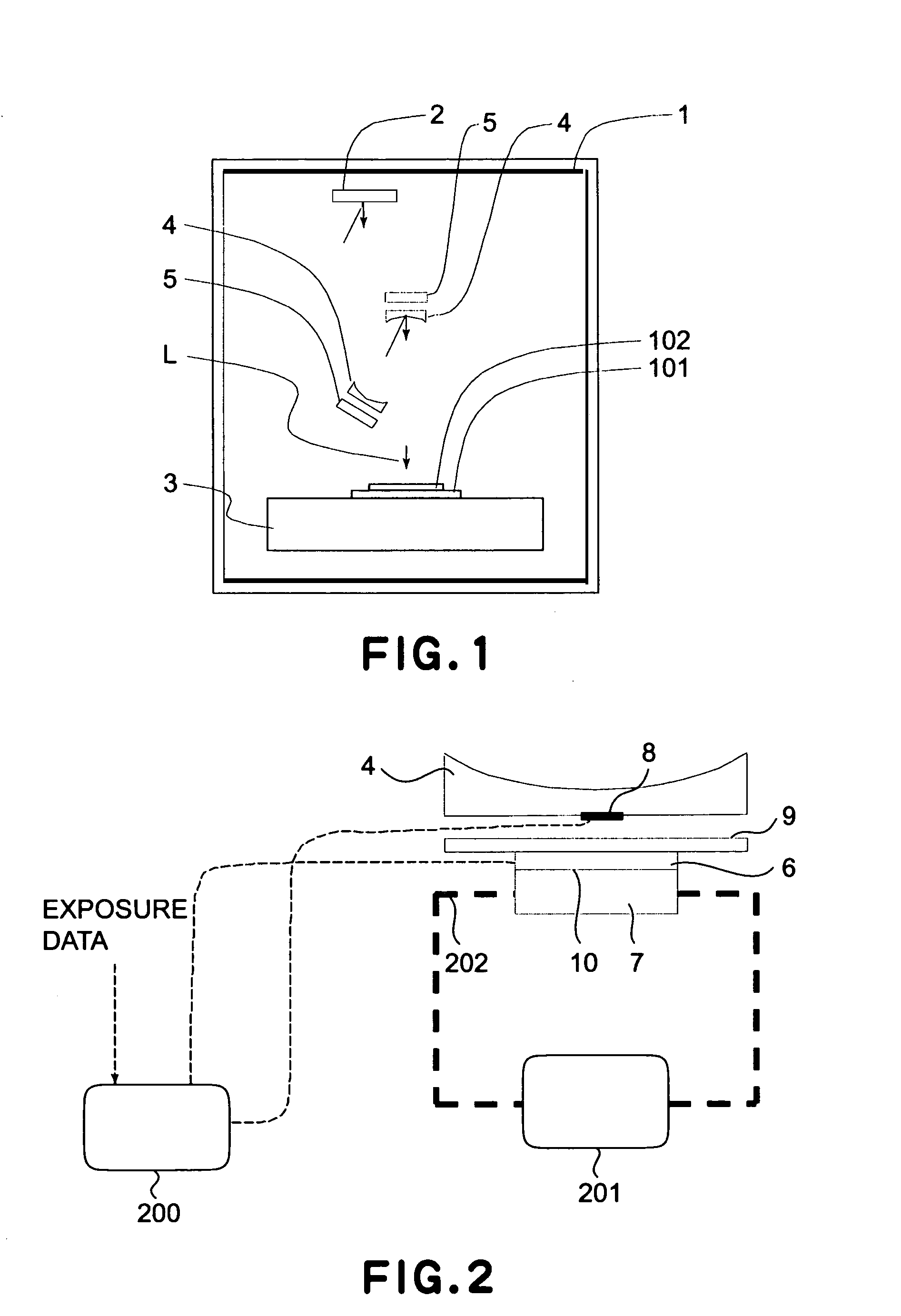Exposure apparatus, cooling method, and device manufacturing method
a technology of cooling technology and equipment, applied in the field of cooling technology for optical components, can solve the problems of reducing the accuracy of the transfer position, affecting the accuracy of the temperature control, and limiting the enlargement of the surface area of opposed surfaces, so as to achieve the effect of improving the accuracy of temperature control due to the delay of control
- Summary
- Abstract
- Description
- Claims
- Application Information
AI Technical Summary
Benefits of technology
Problems solved by technology
Method used
Image
Examples
first embodiment
[0025]FIG. 1 is a schematic view for explaining an example of exposure apparatus based on a cooling method, according to a first embodiment of the present invention. Denoted at 1 is a chamber which functions to separate an exposure ambience from an atmosphere. A vacuum is maintained in the chamber, by means of a pump, not shown. Exposure light L directed from an unshown illumination optical system is reflected by a reticle 2. The exposure light L as reflected by the reticle 2 is reflected by mirrors of a projection optical system and projected upon a wafer 102, whereby a pattern of the reticle 2 is transferred to the wafer 102. Wafer 102 is in a wafer chuck 101 mounted on a block 3. There is a radiation cooling mechanism 5 disposed opposed to the bottom face of the mirror 4.
[0026]FIG. 2 is a schematic view of the radiation cooling mechanism. The radiation cooling mechanism 5 comprises a Peltier device 6, a heat radiating (dissipation) block 7, and a radiation plate 9. The Peltier el...
second embodiment
[0045]A second embodiment of the present invention concerns a cooling method wherein every mirror is cooled in accordance with the procedure shown in FIG. 3. More specifically, as shown in FIG. 6, mirrors may have different shapes. Also, heat loads applied to the mirrors may be different from each other. Thus, the timing for changing the temperature of the radiation plate 9 to be calculated by step 22 may differ between the mirrors. In consideration of it, in accordance with the present embodiment, with respect to each of plural mirrors, a function or a table that represents the output timing and the output level to heat loads, to be used at step 22, is prepared. With this arrangement, a signal can be applied at an optimum timing in relation to each mirror. Thus, in regard to all the mirrors, the temperature can be controlled with good precision, within a tolerable temperature variation range.
[0046]While the foregoing embodiments have been described specifically with respect to a co...
third embodiment
[0048]A third embodiment of the present invention is directed to a cooling method wherein the present invention is applied to a process for cooling a wafer chuck, not a mirror, as shown in FIG. 7.
[0049]Denoted in FIG. 7 at 102 is a wafer, and denoted at 101 is a wafer chuck. Denoted at 9 is a radiation cooling plate, and denoted at 6 is a Peltier device. Since any thermal deformation of the wafer chuck 101 directly leads to deformation of a wafer 102, it is very important for improvements of pattern transfer precision of an exposure apparatus to suppress temperature variation of the wafer chuck 101. The wafer chuck 101 is made of a material having a high specific rigidity, such as SiC, for example, so as to suppress deformation due to any external force.
[0050]Here, for better performance of a wafer stage (lightness or rigidity, for example), the material of the wafer chuck should desirably have a specific rigidity of 1E+8 (N·m / kg) or more.
[0051]Further, in order that the wafer chuck...
PUM
| Property | Measurement | Unit |
|---|---|---|
| temperature | aaaaa | aaaaa |
| temperature | aaaaa | aaaaa |
| diameter | aaaaa | aaaaa |
Abstract
Description
Claims
Application Information
 Login to View More
Login to View More - R&D
- Intellectual Property
- Life Sciences
- Materials
- Tech Scout
- Unparalleled Data Quality
- Higher Quality Content
- 60% Fewer Hallucinations
Browse by: Latest US Patents, China's latest patents, Technical Efficacy Thesaurus, Application Domain, Technology Topic, Popular Technical Reports.
© 2025 PatSnap. All rights reserved.Legal|Privacy policy|Modern Slavery Act Transparency Statement|Sitemap|About US| Contact US: help@patsnap.com



